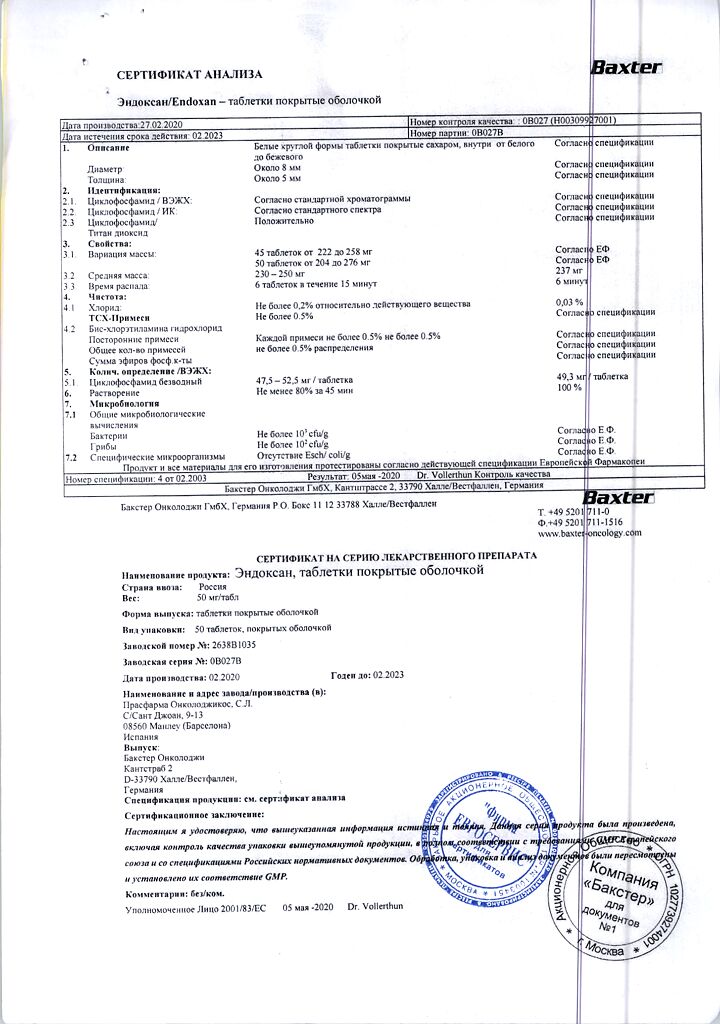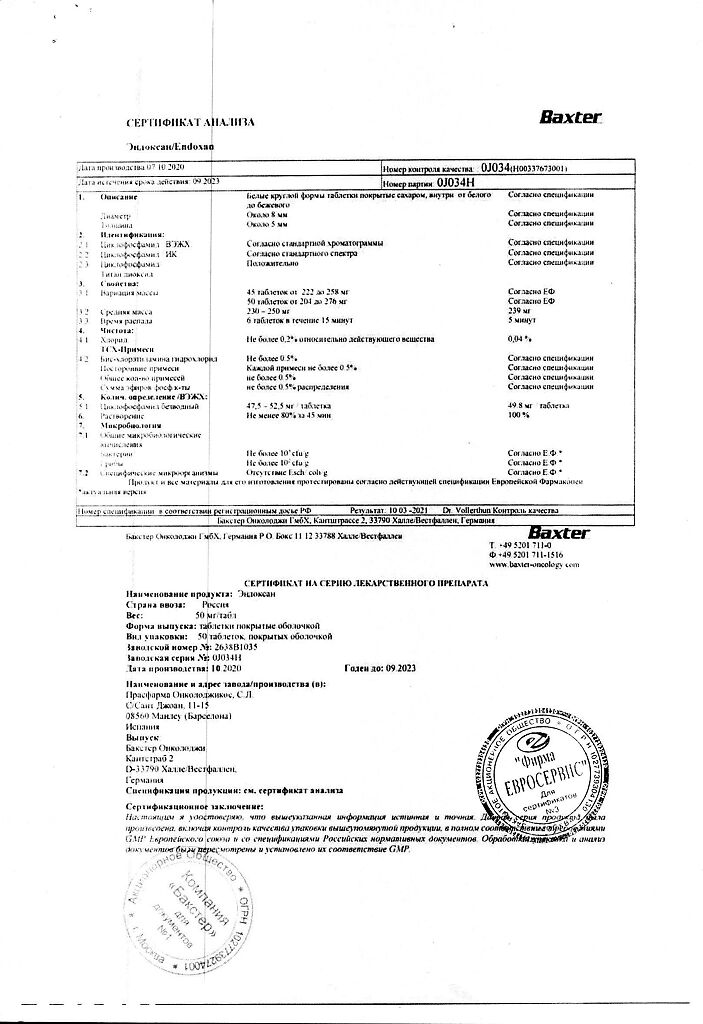No products in the cart.
Description
Pharmacodynamics
An alkylating antitumor agent. It has cytostatic and immunosuppressive effects. Antitumor action is realized directly in tumor cells where cyclophosphamide is biotransformed under the action of phosphatases with the formation of active metabolite with alkylating effect.
Pharmacokinetics
After a single IV administration, plasma concentrations of cyclophosphamide and its metabolites decrease rapidly in the first 24 h, but can be determined within 72 h. When administered orally, concentrations of cyclophosphamide and its metabolites are almost the same as when administered intravenously.
T1/2 from plasma after IV administration averages 7 h in adults and about 4 h in children. It is excreted with urine and bile.
Indications
Indications
Active ingredient
Active ingredient
Composition
Composition
1 tablet contains:
Active ingredients:
Cyclophosphamide 50 mg.
There are 10 tablets in a blister.
There are 5, 40, 100 or 200 blisters in the carton.
How to take, the dosage
How to take, the dosage
It is set individually, depending on the indication and stage of the disease, the state of the hematopoiesis system, the scheme of anti-tumor therapy.
Interaction
Interaction
Concomitant use of cyclophosphamide may increase the effect of hypoglycemic drugs.
Combined use with allopurinol may lead to increased myelotoxicity.
When used concomitantly with indirect anticoagulants there may be changes in anticoagulant activity (as a rule, cyclophosphamide reduces the synthesis of clotting factors in the liver and interferes with platelet formation).
If used in combination with cytarabine, daunorubicin or doxorubicin, increased cardiotoxic effects are possible.
Combined use with immunosuppressants increases the risk of infections and secondary tumors.
Concomitant use of cyclophosphamide with lovastatin increases the risk of acute skeletal muscle necrosis and acute renal failure.
Drugs that are inducers of microsomal enzymes cause increased formation of active metabolites of cyclophosphamide, which leads to enhancement of its action.
Special Instructions
Special Instructions
It is not recommended for use in patients with varicella (including those with a recent history of or following exposure to the disease), herpes zoster and other acute infectious diseases.
With caution, use in patients with a history of gout or nephrolithiasis, and after adrenalectomy (correction of hormone replacement therapy and doses of cyclophosphamide is necessary).
Cyclophosphamide is used with caution in patients with bone marrow infiltration by tumor cells as well as in patients who received antitumor chemotherapy or radiation therapy.
In the course of treatment it is necessary to control the peripheral blood picture systematically: during the main course 2 times a week; during maintenance treatment – once a week. If the leukocyte count decreases to 2500/μL and the platelet count to 100,000/μL, treatment should be discontinued.
With therapy, hepatic transaminases and LDH activity, bilirubin level, uric acid concentration in plasma, urine output and urine specific gravity are monitored, and tests for microhematuria are performed.
When using cyclophosphamide at higher doses for the prevention of hemorrhagic cystitis, administration of mesna is appropriate.
The carcinogenic and mutagenic effects of cyclophosphamide have been established in experimental studies.
Contraindications
Contraindications
Side effects
Side effects
Digestive system: nausea, vomiting, diarrhea, stomach pain; rarely – toxic hepatitis.
Hematopoietic system disorders: leukopenia, thrombocytopenia, anemia.
Respiratory system: with prolonged use of high doses – pneumonitis or interstitial pulmonary fibrosis.
Cardiovascular system: tachycardia, dyspnea, acute myopericarditis; in some cases – severe heart failure (associated with hemorrhagic myocarditis and myocardial necrosis).
Urinary system disorders: aseptic hemorrhagic cystitis, nephropathy (associated with hyperuricemia).
Reproductive system disorders: menstrual cycle disorders, amenorrhea, azoospermia.
Allergic reactions: skin rash, urticaria, anaphylactic reactions.
Others: alopecia, muscle and bone pain, headache.
Overdose
Overdose
Treatment: the use of supportive measures, including appropriate treatment of infections, manifestations of myelosuppression and/or cardiotoxicity. There is no specific antidote. Treatment is symptomatic.
Pregnancy use
Pregnancy use
Cyclophosphamide is contraindicated in pregnancy. If it is necessary to use during lactation, discontinuation of breastfeeding should be considered.
Women of childbearing age should use reliable methods of contraception during therapy.
The teratogenic and embryotoxic effects of cyclophosphamide have been established in experimental studies.
Additional information
| Weight | 0.036 kg |
|---|---|
| Shelf life | 3 years |
| Conditions of storage | At a temperature not exceeding 25 °C |
| Manufacturer | Praspharma SL, Spain |
| Medication form | pills |
| Brand | Praspharma SL |
Related products
Buy Endoxan, 50 mg 50 pcs. with delivery to USA, UK, Europe and over 120 other countries.




















